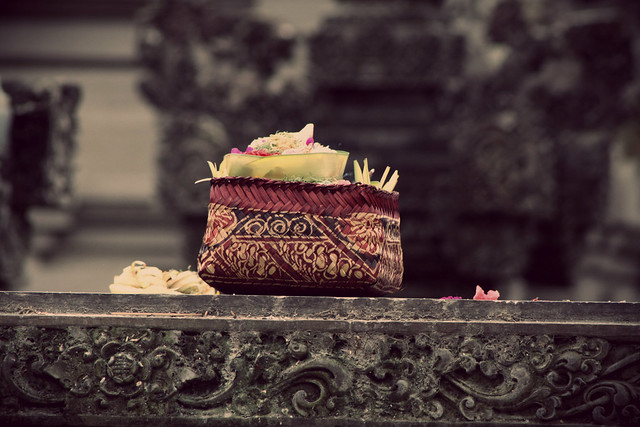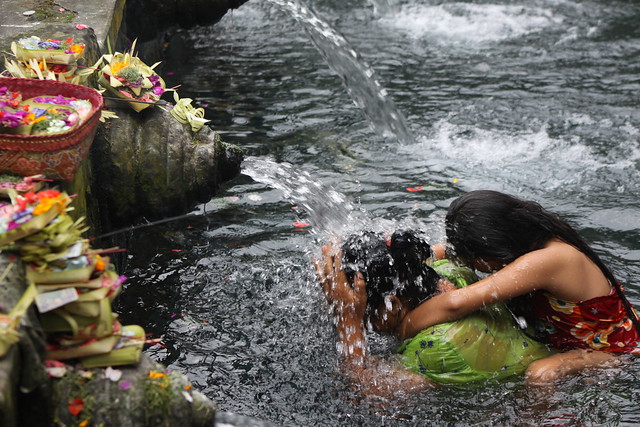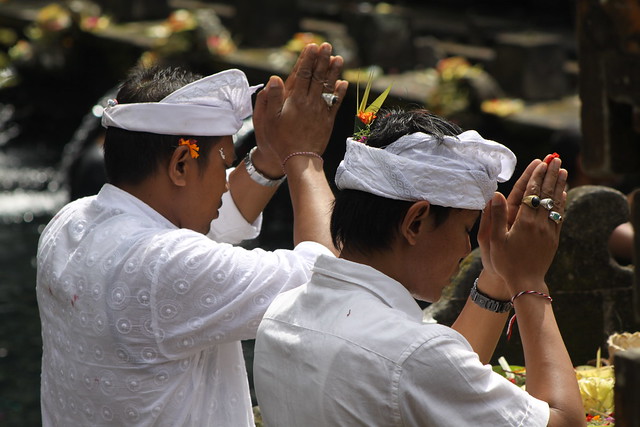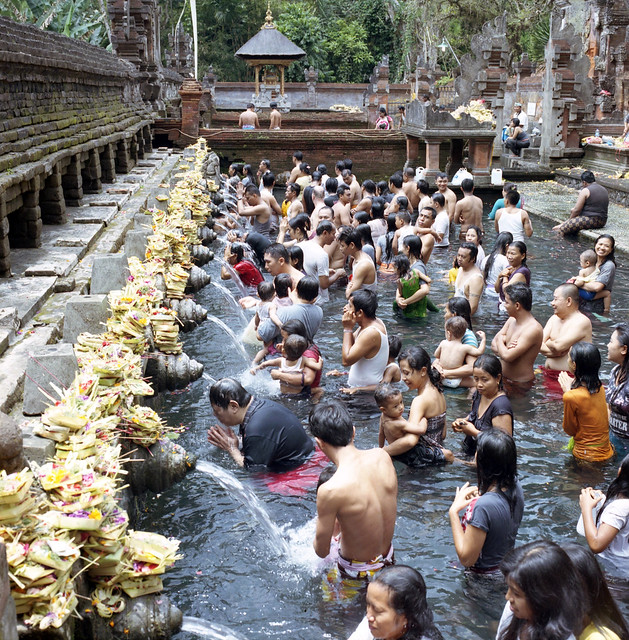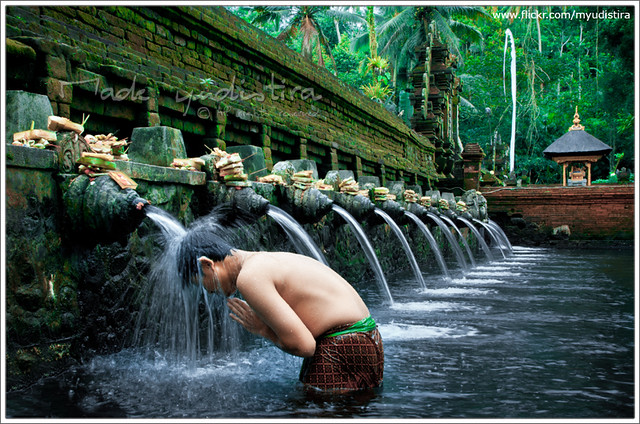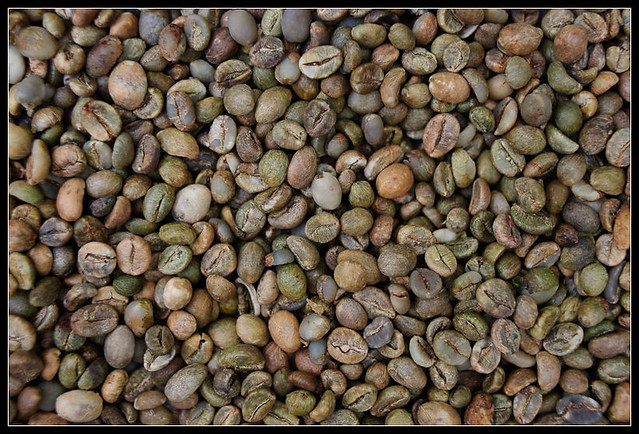Tampaksiring, in the Northern reaches of the Gianyar region of Bali, is something of a market town that has grown around the popularity of its two major tourist attractions: the holy water temple, Tirta Empul and the new world heritage site, Gunung Kawi.
When you first enter the town of Tampaksiring, it strikes you as having once been a proud and thriving community. The town is built close to two historic temples that feed the town with spiritual presence and attract Hindus from all over the island to bathe in their holy waters and meditate on the grandeur of their buildings. Of the many temples that Bali has to offer, these stand out as some of the best to visit.
Nowadays the town is a slightly depressing shell, stretching miles along the main road and lining it with artisan craft shops that are on par with the quality of those that thrive in Ubud, yet remain empty and desperate. Although Tampaksiring is visited en masse by tourists, they fill the tour buses and only frequent the two or three very specific hotspots, leaving the remains of the market town untouched.
In the short time we pulled up to browse, several other shopkeepers selling matching wares ran out of their shops to urgently attempt to pull us in to their own. These aren’t mass-produced goods and the painstakingly detailed but crude production process can often be viewed in the back rooms of the shops. The wood-carvings are particularly spectacular but the market for such products doesn’t seem to exist here.
Getting There
Driving to Tampaksiring takes in a beautiful route from Ubud. The sharp, steep drops and climbs can be a little difficult and the poor 125cc scooter engines scream at the top of their lungs when they see the gradient. Stick with it; it is well worth the climb. The hill plateaus to a 360 degree view of stunning rice fields and little else. Tourism hasn’t yet grabbed this little spot of heaven and there has been a relatively small amount of development. Check it out while you can.
Head East from Ubud and keep going until you pass the Maya Ubud on your right. Drop into the deep valley then make the winding climb out of the other side.
We stopped for lunch at Padi Organic restaurant, one of the only eateries in this glorious green getaway. The staff are incredibly friendly and seem genuinely happy to have you there. The food is excellent too.
After feasting on the food and the views, keep following the winding road through a couple of villages until you hit the main road, Jalan Raya Pejeng Tampaksiring. Head north for 20 minutes and you can’t miss it.
The route can be a little difficult to navigate if you go unprepared, but getting lost out here can be pretty fun. The villages are tiny and decorated all over with bunting and smiles. It was while getting myself lost that I discovered the oft-beautiful terracotta brickwork that patterns most of the Balinese buildings is not always as it seems. One new building that we pulled up next to was a full shell of dull, cheap, grey brick, currently being strategically spray painted a burnt orange colour to give it that authentic terracotta vibe. Brilliant.
Stopping for directions was also interesting. We were specifically looking for the water temple, and couldn’t remember the name of the town, so we asked for Tirta Empul.
“Tirta Empul?” I asked and pointed my intended direction.
“You want temple?”
“Yeah, Tirta Empul temple.” I stuttered, offering up my best Ronnie Barker.
“Temple…”
The kind lady seemed more bemused than me. Turns out it was just across the road.
https://www.youtube.com/watch?v=PxtS7bVtr28
Tirta Empul
Tirta Empul is the more famous of the two temples and the one that pull the crowds to Tampak Siring. Built around a central natural spring of holy water, the temple grounds are split between tourist photo opportunities and out of bounds prayer areas. This gives the whole place an odd cattle market feeling, as you find yourself swept into the herd, milling around in queues to take photographs at the hotspots. I can’t condemn this; I was as guilty as everyone else, but there is a lack of personality in these situations. It is a shame, because the temple would be incredibly serene if not for the crowds.

The holy water in the spring holds all kinds of wildlife, from tiny fish, to Koi, to water snakes. It sits between two large open praying areas, where prayers and meditation are accompanied by offerings and gentle chanting and chimes. We had arrived on Indonesian independence day so the temple was brimming with people who were performing blessing rituals with wonderful passion.
The holy water funnels through several stone fountains to pour into a bathing pool in which visitors can wash away their sins. The purifying process in Bali is very important. Before prayers can be offered, it is essential that a Balinese Hindu receive a blessing with holy tirtha (Balinese for holy water). Despite the crowds, there is something very calming about watching entire families take great reverence and pleasure in the cleansing process.
The well practiced seem to completely lose themselves in the cleanse and the young children, who may be visiting for the first time, almost always reach that heartwarming moment where their initial fear of the fountains subsides to uninhibited glee.
Toward the corner of the compound there is a large pond filled with huge Koi Carp. Here you can buy a little packet of fish food, which is probably the reason the fish are so big – almost every child visitor seemed head over heels at the opportunity to feed the frenzy. I’m not 100% sure about the morality of the overlooking restaurant boasting BBQ’d fish as the special of the day, but hey, I don’t run the place.
If you are planning a visit to the water temple, be aware that you will not be allowed to enter without a sarong covering your knees. These are provided at the gate with the purchase of an entry ticket, but they must be worn at all times. The main temple cannot be entered if your sarong is wet, so be sure to see the rest of the grounds before dipping in the cleansing pool, or just take a spare sarong.
Unlike many tourist attractions in Bali, here the local guides seem very friendly, professional and approachable. We opted out in favour of solo exploration, but almost anyone you ask will be happy to explain a little of the history of the temple.
There is a beautiful garden at the right side of the temple where the wet sarongs are hung, which oddly adds charm to the view. A little bamboo water feature plays a rhythmic drumming that is lovely and calming. If you can make it to Tirta Empul before the crowds do in a morning, this is exactly where you should sit.
When you leave Tirta Empul, the guards on the entrance will insist you leave through the back door, funnelling you through a maze of gift-shops and overpriced conveniences, despite being able to see the car park just 50 yards away. I get it, but if anything it makes you walk with your head down, refusing to be shoehorned into a pressured buying situation. It must work on the big bus tours to be able to sustain the sheer number of shops.
Gunung Kawi
Gunung Kawi is an ancient temple that dates back to the 11th century. Ten large stone carvings line the valley, five on each side of the river that flows through the dense, luscious temple grounds. Legend has it that the carvings were a single night’s labour of the powerful warrior demi-god, Kebo Iwa, who carved with his fingernails alone.
Although Gunung Kawi is impressive in its stone carvings and architecture, it manages to somehow remain subtle and organic. The steep steps funnel toward the valley bottom, hugging its contours and complimenting nature without seeming intrusive. The place is a feat of human engineering, but there is a fantastic feeling of having stumbled upon a secret natural wonder.
The gardens are beautiful, the river is life-giving and nature has been left alone to overgrow and reclaim the parts that look better reclaimed.
Gunung Kawi is not a huge place (an hour will be plenty of time to see everything) but after a long climb down and before a long climb back up, there are plenty of secret corners that would be great for a picnic or some time to chill out.
The temple is located fairly near to Tirta Empul. On your way back toward Ubud through the centre of the town, keep your eye out for a sign on your left and follow the road down. There is another tunnel of endless sarong and souvenir shops that line the path to the attraction, and yet again you are forced to walk through them, as no vehicles are allowed down the road. Be prepared for hawkers gradually decreasing the price of a ‘mandatory’ sarong as you approach the temple and the desperation rises. They will tell you that you MUST buy a sarong from them or you won’t be able to enter the temple. Once again, sarongs are provided for those who buy a ticket, so don’t worry.
Many of the shops that line the steps down to the valley bottom do stock cheap umbrellas for hire in case you turn up on a rainy day like we did, so bare in mind it is still worth the descent even if the heavens open.
I recommend exploring every nook and cranny, as the twists and turns of Gunung Kawi reward its explorers with secret moments of solitude and several different perspectives of the temple grounds. Be prepared for a climb.








